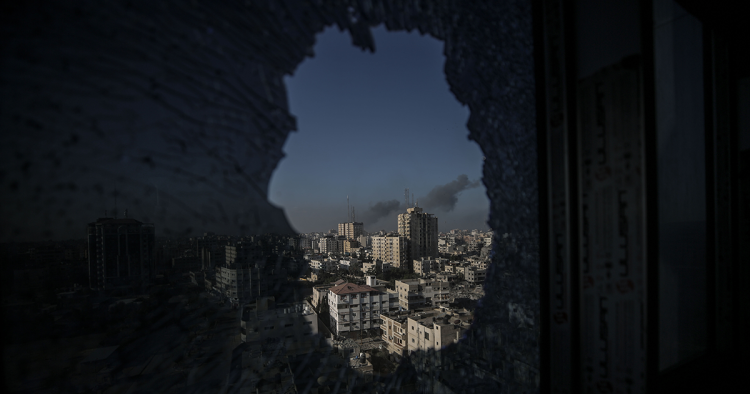Four weeks since Hamas’ attack on Israel and the start of the latter’s retaliatory military operation, the ultimate outlines of Israel’s war plan in Gaza remain unclear. The declared aim is to destroy Hamas — but that runs counter to the second goal of convincing it to release over 200 hostages. The first aim would require a full re-occupation of the Gaza Strip, but it is not clear if that is militarily achievable. Even if it were, the human, political, and economic costs to Israel over the coming weeks and months may not continue to seem worth it to Israelis, especially as Hamas presumably has long prepared for just such a battle, and the steadily rising costs for Palestinian civilians will dramatically increase regional and international pressure on Israel to stop. Pursuing the first aim also carries a substantial risk that if Israel is making real progress toward defeating Hamas, the likelihood of Iran opening a full second front — via Hezbollah and other proxies in Syria — becomes quite high.
Israel seems to be cognizant of these competing pressures, having postponed any ground invasion for three weeks, and even as it has begun to expand its ground incursions, they remain limited, rather than a full-scale ground assault. Indeed, this might be the pattern of the conflict for the coming months: continued overall siege and aerial bombardment, but with patch-by-patch ground operations to try to find and defeat Hamas fighters and close off their tunnels — aiming to clear one area before moving to the next. In such a pattern, the war would be set to go on for many months, with military deaths on both sides and thousands more Palestinian civilians killed, but likely no decisive military outcome.
One potential scenario is that after months of fighting, Israel will control one part of Gaza while Hamas retains control of another, with both sides having fought each other to exhaustion as a desperate and devastated civilian population continues to cry out for help. At that point, the two might engage in prisoner and hostage exchanges and try to agree to some new truce arrangements. But this will not resolve any of the underlying conditions nor buy any lasting peace.
War is presumably the continuation of politics by other means. But neither side seems to have an achievable long-term political goal in mind. In perpetrating the horrific attacks of Oct. 7, Hamas was perhaps giving vent to atavistic frustration, but it has created predictable and enormous suffering for the people of Gaza, undermined the moral ground of the Palestinian cause by engaging in ISIS-like acts of terror, and in the process pushed Israeli opinion even harder to the right. In Israel, the political landscape is fractured and unclear. The national unity cabinet seems low on unity, and wartime leader Benjamin Netanyahu does not have the confidence of many in his own government or military, nor many in the Israeli public. The emotional need to respond with overwhelming force to the unprecedented attacks of Oct. 7 runs up against the realities that a re-occupation of Gaza will neither be easy nor likely to lead to a clear or sustainable outcome. Indeed, an aerial bombing campaign that kills thousands of civilians will only shift global attention away from the Oct. 7 attacks and toward Israel’s massive reaction as well as bolster the competing public pressure to prioritize the release of hostages.
In the long term, this conflict is between two people struggling over whether and how to share the small piece of real estate that they both call home. In this broader context, there is no military solution, only a political one. President Joe Biden has made it clear that there can be no return to the status quo ante Oct. 7, but rather there must be a way forward toward negotiating and something resembling a two-state solution. And now, unlike in previous decades, there is a receptive neighborhood of Arab states eager to engage and provide support and assurances in that direction. The current Israeli leadership, with its focus on responding to Hamas’ attack, has not responded in kind. This is likely part of Hamas’ original design: to destroy all pathways to a negotiated settlement locally or regionally and to drive Israelis into a maximalist and politically counterproductive response. The only long-term way of building security and stability, and reducing violence for Palestinians and Israelis alike, is to create hope and establish a political pathway for both sides. Another war on Hamas and Gaza will not alter this logic. Only a bold strategy of pivoting toward peace will change the dangerous future. Anwar Sadat understood that well. Yitzak Rabin did too. Are there leaders in Israel, Palestine, the Arab world, and the U.S. that can see that as well and make it happen?
Paul Salem is the president and CEO of the Middle East Institute.
Photo by Ali Jadallah/Anadolu via Getty Images
The Middle East Institute (MEI) is an independent, non-partisan, non-for-profit, educational organization. It does not engage in advocacy and its scholars’ opinions are their own. MEI welcomes financial donations, but retains sole editorial control over its work and its publications reflect only the authors’ views. For a listing of MEI donors, please click here.













